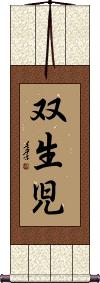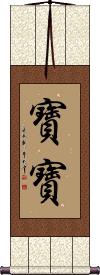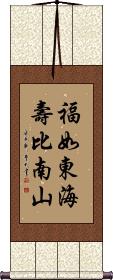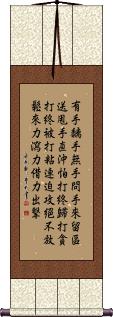Many custom options...
And formats...

Scrolls in Chinese / Japanese...
Buy a Scrolls calligraphy wall scroll here!
Personalize your custom “Scrolls” project by clicking the button next to your favorite “Scrolls” title below...
Twins
Baby
寶寶 is how Chinese people express “baby.”
The word is composed of the same character twice, and therefore literally means “double precious” or “double treasure.”
This would be a nice wall scroll to put either inside or by the door of your baby's room (not on the door, as wall scrolls swing around wildly when hung on doors that open and close a lot).
Longevity / Long Life Wishes
A wish for a long and prosperous life
福如東海壽比南山 is a phrase that means “May you have good fortune as great as the eastern oceans, and may your life last as long as the southern mountains.”
In ancient Chinese mythology, the eastern oceans and southern mountains are where God resides (basically it is the same as saying “heaven”). So it's like saying, “May your good fortune and life be as vast as the heavens.”
There is also a longer, 14-character version of this phrase. Also, this can be cut into two scrolls (with half the phrase on each side - great for hanging on either side of a doorway). Just let me know if you'd like a special version (there is an additional cost).
Wing Chun Fist Maxims (Part 1)
A customer asked me to split these Wing Chun maxims into two parts, so he could order a couplet. I thought this was a good idea, so it's been added here.
1 有手黐手,無手問手
2 來留區送, 甩手直沖
3 怕打終歸打, 貪打終被打
4 粘連迫攻, 絕不放鬆
5 來力瀉力, 借力出擊
A couplet is a set of two wall scrolls that start and finish one phrase or idea. Often, couplets are hung with the first wall scroll on the right side, and the second on the left side of a doorway or entrance. The order in Chinese is right-to-left, so that's why the first wall scroll goes on the right as you face the door.
Of course, couplets can also be hung together on a wall. Often they can be hung to flank an altar, or table with incense, or even flanking a larger central wall scroll. See an example here from the home of Confucius
Be sure to order both parts 1 and 2 together. One without the other is like Eve without Adam.
A Traditional Warm Welcome
歡迎光臨 would be the ultimate Chinese “welcome mat.” Except it will be on your wall, and people will not step on it.
In a somewhat literal translation, you could say it means “I feel happy as I welcome you, as you have brought a shining light to this place with your arrival,” or more simply, “I am happy you've come as your presents brightens up the place.”
It has become common for this greeting to be announced by the staff upon the arrival of any customer into a fancy store in China. You will also see these characters on the “welcome mats” in front of 4 and 5-star hotels in China.
Having this on a wall scroll is an extra nice touch. I have seen a few horizontal scrolls with this phrase on the wall behind the reception desk of better hotels or near the front door of fine shops. At the fanciest department stores and restaurants in China, several greeters (almost always young women) will stand by the front door, all wearing sashes with this phrase embroidered. As you walk in, they will bow and say “huan ying guang lin” to welcome you to the establishment.
Note: The first two and last two characters do make words in Korean Hanja but are seldom used as a sentence like this in Korean.
Not the results for Scrolls that you were looking for?
Below are some entries from our dictionary that may match your Scrolls search...
| Characters If shown, 2nd row is Simp. Chinese |
Pronunciation Romanization |
Simple Dictionary Definition |
幅 see styles |
fú fu2 fu fuku ふく |
width; roll; classifier for textiles or pictures (1) scroll; (suf,ctr) (2) (also ぶく, ぷく) counter for scrolls; (surname) Fuku |
万巻 see styles |
mangan まんがん |
many scrolls; many books |
元史 see styles |
yuán shǐ yuan2 shi3 yüan shih motofumi もとふみ |
History of the Yuan Dynasty, twenty third of the 24 dynastic histories 二十四史[Er4 shi2 si4 Shi3], compiled under Song Lian 宋濂[Song4 Lian2] in 1370 during the Ming Dynasty, 210 scrolls (personal name) Motofumi |
北史 see styles |
běi shǐ bei3 shi3 pei shih hokushi ほくし |
History of the Northern Dynasties, fifteenth of the 24 dynastic histories 二十四史[Er4 shi2 si4 Shi3], compiled by Li Yanshou 李延壽|李延寿[Li3 Yan2 shou4] in 659 during Tang Dynasty, 100 scrolls (given name) Hokushi |
南史 see styles |
nán shǐ nan2 shi3 nan shih nanshi なんし |
History of the Southern Dynasties, fourteenth of the 24 dynastic histories 二十四史[Er4 shi2 si4 Shi3], compiled by Li Yanshou 李延壽|李延寿[Li3 Yan2 shou4] in 659 during Tang Dynasty, 80 scrolls (given name) Nanshi |
双幅 see styles |
soufuku / sofuku そうふく |
pair of hanging scrolls |
周書 周书 see styles |
zhōu shū zhou1 shu1 chou shu |
History of Zhou of the Northern Dynasties, twelfth of the 24 dynastic histories 二十四史[Er4 shi2 si4 Shi3], compiled under Linghu Defen 令狐德棻[Ling2 hu2 De2 fen1] in 636 during Tang Dynasty, 50 scrolls |
唐書 唐书 see styles |
táng shū tang2 shu1 t`ang shu tang shu |
same as 舊唐書|旧唐书[Jiu4 Tang2 shu1], History of the Early Tang Dynasty, sixteenth of the 24 dynastic histories 二十四史[Er4 shi2 si4 Shi3], compiled under Liu Xu 劉昫|刘昫[Liu2 Xu4] in 945 during Later Jin 後晉|后晋[Hou4 Jin4] of the Five Dynasties, 200 scrolls |
宋史 see styles |
sòng shǐ song4 shi3 sung shih soushi / soshi そうし |
History of the Song Dynasty, twentieth of the 24 dynastic histories 二十四史[Er4 shi2 si4 Shi3], composed under Toktoghan 脫脫|脱脱[Tuo1 tuo1] in 1345 during the Yuan Dynasty 元[Yuan2], 496 scrolls; (not to be confused with 宋書|宋书[Song4 shu1]) (work) Songshi; History of Song (one of the official Twenty-Four Histories of China); (wk) Songshi; History of Song (one of the official Twenty-Four Histories of China) |
宋書 宋书 see styles |
sòng shū song4 shu1 sung shu |
History of Song of the Southern Dynasties 南朝宋[Nan2 chao2 Song4] or Liu Song 劉宋|刘宋[Liu2 Song4], sixth of the 24 dynastic histories 二十四史[Er4 shi2 si4 Shi3], compiled by Shen Yue 沈約|沈约[Shen3 Yue1] in 488 during Liang of the Southern Dynasties 南朝梁[Nan2 chao2 Liang2], 100 scrolls; (not to be confused with 宋史[Song4 shi3]) |
対聯 see styles |
tsuiren; tairen ついれん; たいれん |
(1) couplet (Chinese poetry); (2) pair of hanging scrolls |
屏條 屏条 see styles |
píng tiáo ping2 tiao2 p`ing t`iao ping tiao |
set of (usually four) hanging scrolls |
巻数 see styles |
kansuu; kanju; kanzu / kansu; kanju; kanzu かんすう; かんじゅ; かんず |
(1) volume number; reel number; scroll number; (2) number of volumes; number of reels; number of scrolls; number of turns (of a coil); number of windings (of a transformer, electromagnet, etc.); (3) (かんじゅ, かんず only) a set number of scrolls to be read by a Buddhist monk |
明史 see styles |
míng shǐ ming2 shi3 ming shih meiji / meji めいじ |
History of the Ming Dynasty, twenty fourth of the 24 dynastic histories 二十四史[Er4 shi2 si4 Shi3], compiled under Zhang Tingyu 張廷玉|张廷玉[Zhang1 Ting2 yu4] in 1739 during the Qing Dynasty, 332 scrolls (personal name) Meiji |
晉書 晋书 see styles |
jìn shū jin4 shu1 chin shu |
History of the Jin Dynasty, fifth of the 24 dynastic histories 二十四史[Er4 shi2 si4 Shi3], compiled under Fang Xuanling 房玄齡|房玄龄[Fang2 Xuan2 ling2] in 648 during Tang Dynasty 唐朝[Tang2 chao2], 130 scrolls |
曝涼 see styles |
bakuryou / bakuryo ばくりょう |
(noun/participle) (See 虫干し) airing of clothes, hanging scrolls, etc. (to prevent damage from insects and mould) |
梁書 梁书 see styles |
liáng shū liang2 shu1 liang shu |
History of Liang of the Southern Dynasties, eighth of the 24 dynastic histories 二十四史[Er4 shi2 si4 Shi3], compiled by Yao Silian 姚思廉[Yao2 Si1 lian2] in 636 during Tang dynasty, 56 scrolls |
法卷 see styles |
fǎ juǎn fa3 juan3 fa chüan hōkan |
dharma-scrolls |
漢書 汉书 see styles |
hàn shū han4 shu1 han shu kanjo かんじょ |
History of the Former Han Dynasty, second of the 24 dynastic histories 二十四史[Er4 shi2 si4 Shi3], composed by Ban Gu 班固[Ban1 Gu4] in 82 during Eastern Han (later Han), 100 scrolls (work) Book of Han (111 CE); History of the Former Han; (wk) Book of Han (111 CE); History of the Former Han The History of Han |
矢筈 see styles |
yahazu やはず |
(1) nock of an arrow; (2) forked tool used for hanging scrolls; (place-name, surname) Yahazu |
經卷 经卷 see styles |
jīng juàn jing1 juan4 ching chüan kyōkan |
volumes of classics; volumes of scriptures; ancient scrolls manuscript |
遼史 辽史 see styles |
liáo shǐ liao2 shi3 liao shih |
History of the Liao Dynasty, twenty first of the 24 dynastic histories 二十四史[Er4 shi2 si4 Shi3], composed under Toktoghan 脫脫|脱脱[Tuo1 tuo1] in 1345 during the Yuan Dynasty 元[Yuan2], 116 scrolls |
金史 see styles |
jīn shǐ jin1 shi3 chin shih kanefumi かねふみ |
History of the Jurchen Jin Dynasty, twenty second of the 24 dynastic histories 二十四史[Er4 shi2 si4 Shi3], composed under Toktoghan 脫脫|脱脱[Tuo1 tuo1] in 1345 during the Yuan Dynasty 元[Yuan2], 135 scrolls (given name) Kanefumi |
陳書 陈书 see styles |
chén shū chen2 shu1 ch`en shu chen shu |
History of Chen of the Southern Dynasties, ninth of the 24 dynastic histories 二十四史[Er4 shi2 si4 Shi3], compiled by Yao Silian 姚思廉[Yao2 Si1 lian2] in 636 during Tang dynasty, 36 scrolls |
隋書 隋书 see styles |
suí shū sui2 shu1 sui shu zuisho ずいしょ |
History of the Sui Dynasty, thirteenth of the 24 dynastic histories 二十四史[Er4 shi2 si4 Shi3], compiled under Wei Zheng 魏徵|魏征[Wei4 Zheng1] in 636 during Tang Dynasty, 85 scrolls (work) Book of Sui; (wk) Book of Sui |
魏書 魏书 see styles |
wèi shū wei4 shu1 wei shu gisho ぎしょ |
History of Wei of the Northern Dynasties, tenth of the 24 dynastic histories 二十四史[Er4 shi2 si4 Shi3], compiled by Wei Shou 魏收[Wei4 Shou1] in 554 during Northern Qi Dynasty 北齊|北齐[Bei3 Qi2], 114 scrolls (personal name) Gisho |
齊書 齐书 see styles |
qí shū qi2 shu1 ch`i shu chi shu |
History of Qi of the Southern Dynasties, seventh of the 24 dynastic histories 二十四史[Er4 shi2 si4 Shi3], compiled by Xiao Zixian 蕭子顯|萧子显[Xiao1 Zi3 xian3] in 537 during Liang of the Southern Dynasties 南朝梁[Nan2 chao2 Liang2], 59 scrolls; usually 南齊書|南齐书[Nan2 Qi2 shu1] to distinguish from Northern Qi |
三國志 三国志 see styles |
sān guó zhì san1 guo2 zhi4 san kuo chih |
History of the Three Kingdoms, fourth of the 24 dynastic histories 二十四史[Er4 shi2 si4 Shi3], composed by Chen Shou 陳壽|陈寿[Chen2 Shou4] in 289 during Jin Dynasty 晉朝|晋朝[Jin4 chao2], 65 scrolls See: 三国志 |
五代史 see styles |
wǔ dài shǐ wu3 dai4 shi3 wu tai shih |
History of the Five Dynasties, eighteenth of the 24 dynastic histories 二十四史[Er4 shi2 si4 Shi3], compiled under Xue Juzheng 薛居正[Xue1 Ju1 zheng4] in 974 during Northern Song 北宋[Bei3 Song4], 150 scrolls |
前漢書 前汉书 see styles |
qián hàn shū qian2 han4 shu1 ch`ien han shu chien han shu |
History of the Former Han Dynasty, second of the 24 dynastic histories 二十四史[Er4 shi2 si4 Shi3], composed by Ban Gu 班固[Ban1 Gu4] in 82 during Eastern Han (later Han), 100 scrolls |
Click here for more Scrolls results from our dictionary
The following table may be helpful for those studying Chinese or Japanese...
| Title | Characters | Romaji (Romanized Japanese) | Various forms of Romanized Chinese | |
| Twins | 双生児 | souseiji / soseiji | ||
| Baby | 寶寶 宝宝 | bǎo bao / bao3 bao / bao bao / baobao | pao pao / paopao | |
| Longevity Long Life Wishes | 福如東海壽比南山 福如东海寿比南山 | fú rú dōng hǎi shòu bǐ nán shān fu2 ru2 dong1 hai3 shou4 bi3 nan2 shan1 fu ru dong hai shou bi nan shan furudonghaishoubinanshan | fu ju tung hai shou pi nan shan fujutunghaishoupinanshan |
|
| Wing Chun Fist Maxims (Part 1) | 有手黐手無手問手來留區送甩手直沖怕打終歸打貪打終被打粘連迫攻絕不放鬆來力瀉力借力出擊 有手黐手无手问手来留区送甩手直冲怕打终归打贪打终被打粘连迫攻绝不放松来力泻力借力出击 | |||
| A Traditional Warm Welcome | 歡迎光臨 欢迎光临 | huān yíng guāng lín huan1 ying2 guang1 lin2 huan ying guang lin huanyingguanglin | huan ying kuang lin huanyingkuanglin |
|
| In some entries above you will see that characters have different versions above and below a line. In these cases, the characters above the line are Traditional Chinese, while the ones below are Simplified Chinese. | ||||
Successful Chinese Character and Japanese Kanji calligraphy searches within the last few hours...








